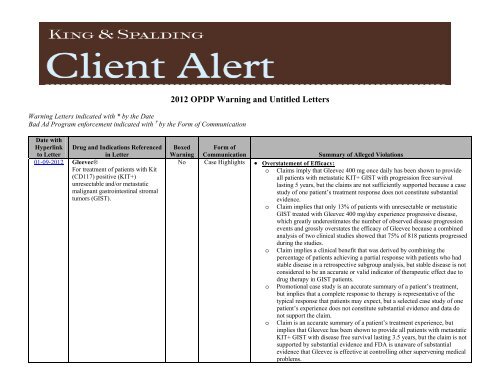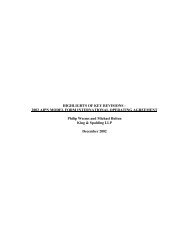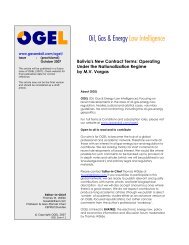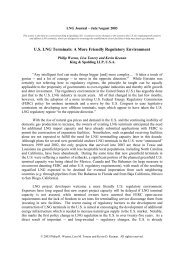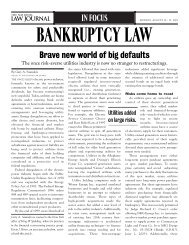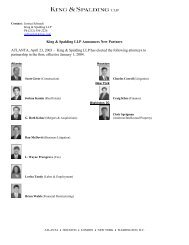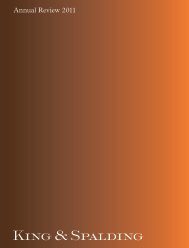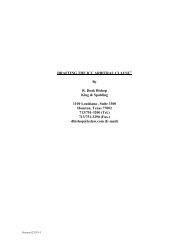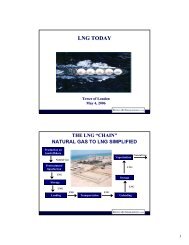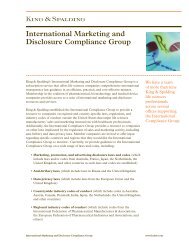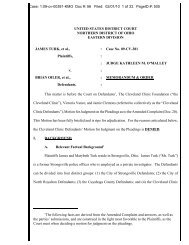Client Alert: 2012 OPDP Warning and Untitled Letters
Client Alert: 2012 OPDP Warning and Untitled Letters
Client Alert: 2012 OPDP Warning and Untitled Letters
Create successful ePaper yourself
Turn your PDF publications into a flip-book with our unique Google optimized e-Paper software.
<strong>Warning</strong> <strong>Letters</strong> indicated with * by the Date<br />
Bad Ad Program enforcement indicated with † by the Form of Communication<br />
<strong>2012</strong> <strong>OPDP</strong> <strong>Warning</strong> <strong>and</strong> <strong>Untitled</strong> <strong>Letters</strong><br />
Date with<br />
Hyperlink Drug <strong>and</strong> Indications Referenced<br />
to Letter<br />
in Letter<br />
01-09-<strong>2012</strong> Gleevec®<br />
For treatment of patients with Kit<br />
(CD117) positive (KIT+)<br />
unresectable <strong>and</strong>/or metastatic<br />
malignant gastrointestinal stromal<br />
tumors (GIST).<br />
Boxed Form of<br />
<strong>Warning</strong> Communication<br />
Summary of Alleged Violations<br />
No Case Highlights Overstatement of Efficacy:<br />
o Claims imply that Gleevec 400 mg once daily has been shown to provide<br />
all patients with metastatic KIT+ GIST with progression free survival<br />
lasting 5 years, but the claims are not sufficiently supported because a case<br />
study of one patient’s treatment response does not constitute substantial<br />
evidence.<br />
o Claim implies that only 13% of patients with unresectable or metastatic<br />
GIST treated with Gleevec 400 mg/day experience progressive disease,<br />
which greatly underestimates the number of observed disease progression<br />
events <strong>and</strong> grossly overstates the efficacy of Gleevec because a combined<br />
analysis of two clinical studies showed that 75% of 818 patients progressed<br />
during the studies.<br />
o Claim implies a clinical benefit that was derived by combining the<br />
percentage of patients achieving a partial response with patients who had<br />
stable disease in a retrospective subgroup analysis, but stable disease is not<br />
considered to be an accurate or valid indicator of therapeutic effect due to<br />
drug therapy in GIST patients.<br />
o Promotional case study is an accurate summary of a patient’s treatment,<br />
but implies that a complete response to therapy is representative of the<br />
typical response that patients may expect, but a selected case study of one<br />
patient’s experience does not constitute substantial evidence <strong>and</strong> data do<br />
not support the claim.<br />
o Claim is an accurate summary of a patient’s treatment experience, but<br />
implies that Gleevec has been shown to provide all patients with metastatic<br />
KIT+ GIST with disease free survival lasting 3.5 years, but the claim is not<br />
supported by substantial evidence <strong>and</strong> FDA is unaware of substantial<br />
evidence that Gleevec is effective at controlling other supervening medical<br />
problems.
222<strong>2012</strong> <strong>OPDP</strong> <strong>Warning</strong> <strong>and</strong> <strong>Untitled</strong> <strong>Letters</strong><br />
Date with<br />
Hyperlink<br />
to Letter<br />
Drug <strong>and</strong> Indications Referenced<br />
in Letter<br />
Boxed<br />
<strong>Warning</strong><br />
Form of<br />
Communication<br />
Summary of Alleged Violations<br />
o Disclaimers stating that case study results “are not necessarily<br />
representative <strong>and</strong> may vary by patient” do not mitigate the misleading<br />
impression of the claims <strong>and</strong> presentations.<br />
Unsubstantiated Efficacy Claims:<br />
o Claim is an accurate summary of a patient’s experience, but implies that<br />
Gleevec is effective at treating melana without support by substantial<br />
evidence.<br />
02-28-<strong>2012</strong> Saphris®<br />
As a monotherapy, for the acute<br />
treatment of manic or mixed<br />
episodes associated with bipolar I<br />
disorder; as an adjunctive therapy<br />
with lithium or valproate, for the<br />
acute treatment of manic or mixed<br />
episodes associated with bipolar I<br />
disorder.<br />
Yes Oral Statements † Promotion of Unapproved Uses:<br />
o Statement made during an oral presentation to a group of healthcare<br />
professionals implies that Saphris is safe <strong>and</strong> effective for use as an<br />
adjunctive treatment for major depressive disorder when Saphris is not<br />
indicated for this use. The statements suggest a new intended use for<br />
Saphris for which the Product Labeling (PI) lacks adequate directions for<br />
use.<br />
03-06-<strong>2012</strong> Atralin<br />
For topical treatment of acne<br />
vulgaris.<br />
No<br />
Direct-to-<br />
Consumer<br />
Website,<br />
Professional<br />
Detail Aid<br />
Unsubstantiated Superiority Claims/Unsubstantiated Claims:<br />
o Claims <strong>and</strong> presentations in the aid suggest that Atralin’s formulation <strong>and</strong><br />
purported greater delivery to the dermis result in superior safety <strong>and</strong><br />
efficacy compared to other tretinoin products <strong>and</strong> that Atralin is more<br />
tolerable than products of similar strength, but FDA is unaware of<br />
substantial evidence for the claims.<br />
o FDA is unaware of evidence demonstrating that Atralin gel has<br />
pharmacological activity in the dermis, <strong>and</strong> there are no data to support the<br />
notion that in vitro percutaneous absorption data predict or correlate with<br />
comparative clinical efficacy because disease state might affect drug<br />
penetration <strong>and</strong> bioavailability <strong>and</strong> the in vitro percutaneous absorption<br />
method is not adequate for assessing comparative in vivo levels clinically<br />
at the dermis for different formulations.<br />
o A small footnote indicating that the clinical significance of in vitro data is<br />
unknown <strong>and</strong> that differences were not statistically significant does not<br />
correct the misleading impression.<br />
o Claims in the website <strong>and</strong> aid suggest that Atralin is clinically superior to<br />
other tretinoin formulations because individual ingredients in Atralin’s<br />
vehicle are purported to provide specific clinical benefits such as<br />
moisturizing skin, but this has not been demonstrated in adequate <strong>and</strong> wellcontrolled<br />
head-to-head clinical trials comparing appropriate doses <strong>and</strong><br />
2
222<strong>2012</strong> <strong>OPDP</strong> <strong>Warning</strong> <strong>and</strong> <strong>Untitled</strong> <strong>Letters</strong><br />
Date with<br />
Hyperlink<br />
to Letter<br />
Drug <strong>and</strong> Indications Referenced<br />
in Letter<br />
Boxed<br />
<strong>Warning</strong><br />
Form of<br />
Communication<br />
Summary of Alleged Violations<br />
dose regimens of the subject drugs, <strong>and</strong> the PI includes statements about<br />
dry skin in patients.<br />
o A statement that the contribution of the individual components of the<br />
vehicle have not been evaluated does not mitigate the misleading<br />
impression.<br />
Overstatement of Efficacy:<br />
o Website claim suggesting that Atralin has specific demonstrated efficacy in<br />
treating “rough” or severe acne is not supported by substantial evidence.<br />
o Aid selectively presents more favorable lesion reduction data from<br />
registration trials while failing to include less favorable Global Severity<br />
Score Success Data, which was also a primary endpoint in trials.<br />
Omission <strong>and</strong> Minimization of Risk Information:<br />
o Website implies that patients are likely to “stick” with their treatment<br />
because there is a “low potential of skin irritation” associated with use<br />
when this is not the case. Website omits material facts about the possible<br />
duration <strong>and</strong>/or severity of skin-related adverse reactions <strong>and</strong> the potential<br />
need for discontinuation of the drug, <strong>and</strong> the PI warns about skin irritation<br />
<strong>and</strong> lists skin-related reactions as the most common adverse reactions.<br />
o Characterizing skin-related reactions as “mild to moderate irritation of the<br />
skin” fails to adequately communicate the specific types of skin irritation<br />
associated with use of Atralin.<br />
o Website <strong>and</strong> detail aid completely omit warning regarding fish allergies.<br />
Unsubstantiated Claims:<br />
o<br />
o<br />
o<br />
Claims <strong>and</strong> schematic in the aid suggest that Atralin’s micronized<br />
formulation confers a beneficial effect on product safety <strong>and</strong>/or efficacy by<br />
enabling the majority of tretinoin particles to enter follicles when this has<br />
not been demonstrated. The cited reference does not provide evidence that<br />
tretinoin enters the follicles <strong>and</strong> provides information on healthy skin.<br />
Disclaimer that the clinical significance of micronization is unknown is<br />
insufficient to correct the misleading impression.<br />
Claim suggesting that patients will experience improvement in satisfaction<br />
with self-appearance after using Atralin is not supported by the cited<br />
analysis because the analysis did not reveal any statistically significant<br />
differences between treatments groups in relevant domains <strong>and</strong> the study<br />
was not adequately designed to evaluate individual components of the<br />
overall composite score.<br />
03-14-<strong>2012</strong>* Copaxone®<br />
For reduction of the frequency of<br />
No<br />
Professional<br />
Exhibit Panels,<br />
3<br />
Overstatement of Efficacy/Unsubstantiated Claims:<br />
o Panel presentations imply that the drug has proven long term safety <strong>and</strong>
222<strong>2012</strong> <strong>OPDP</strong> <strong>Warning</strong> <strong>and</strong> <strong>Untitled</strong> <strong>Letters</strong><br />
Date with<br />
Hyperlink<br />
to Letter<br />
Drug <strong>and</strong> Indications Referenced<br />
in Letter<br />
relapses in patients with Relapsing-<br />
Remitting Multiple Sclerosis<br />
(RRMS), including patients who<br />
have experienced a first clinical<br />
episode <strong>and</strong> have PRI features<br />
consistent with multiple sclerosis.<br />
Boxed<br />
<strong>Warning</strong><br />
Form of<br />
Communication<br />
Webpages<br />
Summary of Alleged Violations<br />
efficacy, but the PI only includes data for up to three years in duration.<br />
The exhibit panels refer to open-label extension studies that do not account<br />
for self-selection among patients who chose to participate in the studies,<br />
<strong>and</strong> it is unclear why certain patients dropped out or were lost to follow-up.<br />
o Claim suggests that Copaxone is superior to other RRMS therapies when<br />
FDA is unaware of support for the claim.<br />
Overstatement of Efficacy/Broadening of Claims:<br />
o Webpage claims imply that Copaxone reverses patients’ disability <strong>and</strong><br />
enables them to lead active <strong>and</strong> regular lifestyles, which may accurately<br />
reflect patients’ experiences, but Copaxone is not indicated for slowing,<br />
preventing, or reversing physical disability associated with RRMS <strong>and</strong><br />
FDA is not aware of substantial evidence or experience supporting the<br />
implication that treatment will result in the magnitude of effects described<br />
in the testimonials. Highlights of other MS patients treated with Copaxone<br />
<strong>and</strong> their subsequent athletic accomplishments are similarly misleading.<br />
o Statement that individual results may vary does not mitigate the misleading<br />
impressions <strong>and</strong> personal experiences of patients.<br />
o The totality of the presentation implies that Copaxone is approved to treat<br />
all types of MS when this is not the case.<br />
o Webpages suggest ongoing treatment <strong>and</strong> imply that Copaxone is effective<br />
for reducing the frequency of relapses or exacerbations for a period of time<br />
beyond the three years that data in the PI covers.<br />
o Panels suggest that 82% of patients on Copaxone were able to walk<br />
independently, but the open-label study cited for the claim does not<br />
constitute substantial evidence <strong>and</strong> the claim misleadingly suggests that<br />
Copaxone prevents the progression of disability.<br />
o A statement on the exhibit panel that Copaxone does not include an<br />
indication for slowing progression of disability is not sufficient to mitigate<br />
the misleading representations.<br />
Omission of Risk Information:<br />
o Webpages <strong>and</strong> patient testimonials include numerous claims regarding the<br />
benefits of Copaxone, but fail to include any risk information associated<br />
with the drug in the body of the webpages <strong>and</strong> testimonials.<br />
o Links to “Important Safety Information” <strong>and</strong> the full PI does not mitigate<br />
the omission of risk information from the webpages.<br />
Omission <strong>and</strong> Minimization of Risk Information/Unsubstantiated<br />
Superiority Presentation:<br />
o Table on panel listing only three risks of Copaxone, numerous risks not<br />
associated with Copaxone, <strong>and</strong> a claim that Copaxone has no warnings or<br />
4
222<strong>2012</strong> <strong>OPDP</strong> <strong>Warning</strong> <strong>and</strong> <strong>Untitled</strong> <strong>Letters</strong><br />
Date with<br />
Hyperlink<br />
to Letter<br />
Drug <strong>and</strong> Indications Referenced<br />
in Letter<br />
Boxed<br />
<strong>Warning</strong><br />
Form of<br />
Communication<br />
o<br />
o<br />
Summary of Alleged Violations<br />
precautions for the adverse events suggests that Copaxone is safer than has<br />
been demonstrated <strong>and</strong> implies that it is safer than other treatments for<br />
RRMS. The PI does not list the other risks, but that does not mean that<br />
such risks are not associated with the drug.<br />
Presentation omits material information about other attributes of Copaxone<br />
therapy that are highly relevant to any decision about whether to prescribe<br />
Copaxone, including contraindications, warnings, <strong>and</strong> other serious risks<br />
such as injection site reactions.<br />
Panel claim that no initial or routine monitoring is required or<br />
recommended suggests that Copaxone is a better <strong>and</strong> safer treatment than<br />
other options for RMMS because it is the only one not requiring initial or<br />
routine monitoring, but a comparison of other attributes of the products <strong>and</strong><br />
other material facts may be necessary in the context of the comparative<br />
presentation even though the monitoring recommendations are consistent<br />
with the product PIs.<br />
Omission of Material Facts:<br />
o<br />
Panel presentation of a relative risk reduction is misleading because it<br />
omits material facts regarding actual relapse rates for Copaxone <strong>and</strong><br />
placebo.<br />
5
222<strong>2012</strong> <strong>OPDP</strong> <strong>Warning</strong> <strong>and</strong> <strong>Untitled</strong> <strong>Letters</strong><br />
Date with<br />
Hyperlink Drug <strong>and</strong> Indications Referenced<br />
to Letter<br />
in Letter<br />
03-14-<strong>2012</strong> Avonex®<br />
For the treatment of patients with<br />
relapsing forms of multiple<br />
sclerosis to slow the accumulation<br />
of physical disability <strong>and</strong> decrease<br />
the frequency of clinical<br />
exacerbations.<br />
Boxed<br />
<strong>Warning</strong><br />
No<br />
Form of<br />
Communication<br />
Direct-to-<br />
Consumer<br />
Webpages<br />
Summary of Alleged Violations<br />
Overstatement of Efficacy:<br />
o Webpage implies that Avonex will enable 80% of patients with relapsing<br />
forms of multiple sclerosis to stay active <strong>and</strong> able for 10 years when<br />
clinical studies in the PI only support efficacy for up to 3 years. The openlabel<br />
follow-up study cited on the webpage is not substantial support.<br />
o Statement that FDA-approved labeling includes up to 3 years of clinical<br />
data does not mitigate the misleading impression.<br />
o Presentation implies that Avonex is effective for each of the individual<br />
functional areas of the Exp<strong>and</strong>ed Disability Status Scale (EDSS) listed on<br />
the webpage, but the study in the PI evaluated impact on total EDSS score,<br />
not each individual functional area.<br />
Omission of Material Information/Unsubstantiated Superiority<br />
Presentation:<br />
o Webpage implies that Avonex is superior to other multiple sclerosis drugs<br />
based on the selected attributes presented in the webpage that are<br />
consistent with the products’ PIs, but the page fails to present information<br />
about other attributes associated with the drugs, such as contraindications,<br />
serious warnings <strong>and</strong> precautions, <strong>and</strong> laboratory test monitoring.<br />
o Some safety information for Avonex is presented on the webpage, but<br />
inclusion of the information in small font at the bottom of the page does<br />
not mitigate the misleading impression.<br />
03-30-<strong>2012</strong> Firmagon®<br />
For treatment of patients with<br />
advanced prostate cancer.<br />
No iPad Sales Aid Unapproved New Use:<br />
o Aid suggests new intended uses for Firmagon as a neojuvant therapy<br />
before local treatment <strong>and</strong> as treatment for patients with a rising prostate<br />
specific antigen (PSA). Firmagon has a general indication for treatment of<br />
advanced prostate cancer, but it has not been approved or evaluated by<br />
FDA as a neojuvant therapy or as a treatment for rising PSA.<br />
Overstatement of Efficacy:<br />
o Claims suggest that the velocity of PSA reduction is clinically meaningful<br />
for patients with advanced prostate cancer, which is not supported by<br />
substantial evidence or experience.<br />
o Statement that PSA results should be interpreted with caution <strong>and</strong> that<br />
there is no evidence to show that rapidity of PSA decline is related to<br />
clinical benefit does not mitigate the misleading impression.<br />
o Claims suggest that the reduction in risk of PSA recurrence is clinically<br />
meaningful or associated with improved disease control or survival when<br />
this has not been demonstrated. Also, PSA levels were monitored as a<br />
secondary endpoint in the pivotal study <strong>and</strong> the referenced study was an<br />
6
222<strong>2012</strong> <strong>OPDP</strong> <strong>Warning</strong> <strong>and</strong> <strong>Untitled</strong> <strong>Letters</strong><br />
Date with<br />
Hyperlink<br />
to Letter<br />
Drug <strong>and</strong> Indications Referenced<br />
in Letter<br />
Boxed<br />
<strong>Warning</strong><br />
Form of<br />
Communication<br />
Summary of Alleged Violations<br />
exploratory subgroup analysis of the pivotal study that does not constitute<br />
substantial evidence.<br />
04-13-<strong>2012</strong> Angiomax®<br />
For use with aspirin: as an<br />
anticoagulant in patients with<br />
unstable angina undergoing<br />
percutaneous transluminal<br />
coronary angioplasty (PTCA); with<br />
provisional use of glycoprotein<br />
IIb/IIIa inhibitor (GPI) as listed in<br />
the REPLACE-2 trial as an<br />
anticoagulant in patients<br />
undergoing percutaneous coronary<br />
intervention (PCI); for patients<br />
with, or at risk of, heparin induced<br />
thrombocytopenia or heparin<br />
induced thrombocytopenia <strong>and</strong><br />
thrombosis syndrome undergoing<br />
PCI.<br />
No Booth Panel Omission of Risk Information:<br />
o Panel completely omits the warning <strong>and</strong> precaution regarding coronary<br />
artery brachytherapy <strong>and</strong> fails to include important material information<br />
regarding the risk of bleeding events.<br />
o Panel fails to convey that the most common adverse event associated with<br />
Angiomax is bleeding.<br />
o Statement directing viewers to the exhibit representative for full<br />
prescribing information does not mitigate the omission of risk information.<br />
Unsubstantiated Superiority Claims:<br />
o Totality of claims <strong>and</strong> presentations misleadingly implies that Angiomax is<br />
more effective than heparin with or without GPI for patients with stable<br />
angina, unstable angina, NSTEM, <strong>and</strong> STEMI who are undergoing PCI,<br />
when this has not been demonstrated.<br />
o A study cited by the panel contains ex vivo findings, which do not correlate<br />
with claims of clinical benefit, so the study is not substantial evidence.<br />
o Panel cites a non-inferiority trial, which is not designed to demonstrate<br />
superiority over other agents, <strong>and</strong> in fact, the study failed to show noninferiority<br />
when analyzed for the endpoint of death or myocardial<br />
infarction at 30 days.<br />
o Two studies cited by the panel were confounded by the administration of<br />
other anti-thrombin agents prior to the r<strong>and</strong>omized study drugs. One cited<br />
study is a reanalysis of a trial that only included patients undergoing PTCA<br />
<strong>and</strong> does not constitute substantial evidence, while two other studies are<br />
review articles that do not mention Angiomax.<br />
o Panel cites a clinical study included in the PI that was a non-inferiority<br />
trial, so it was not designed to demonstrate superiority over other agents.<br />
04-26-<strong>2012</strong> Astepro®<br />
For the relief of the symptoms of<br />
seasonal <strong>and</strong> perennial allergic<br />
rhinitis in patients 12 years of age<br />
<strong>and</strong> older.<br />
No<br />
Professional<br />
Telephone Script<br />
7<br />
Omission of Risk Information:<br />
o Script includes efficacy claims, but entirely omits all risk information<br />
associated with use of Astepro.<br />
o Script indicates that the purpose of the call is to share the benefits of <strong>and</strong><br />
important safety information for Astepro <strong>and</strong> that sales representatives<br />
should follow the appropriate procedures for adverse events, but these<br />
statements do not mitigate the misleading presentation.<br />
Overstatement of Efficacy:<br />
o Script implies that Astepro is effective in the treatment of the specific
222<strong>2012</strong> <strong>OPDP</strong> <strong>Warning</strong> <strong>and</strong> <strong>Untitled</strong> <strong>Letters</strong><br />
Date with<br />
Hyperlink<br />
to Letter<br />
Drug <strong>and</strong> Indications Referenced<br />
in Letter<br />
Boxed<br />
<strong>Warning</strong><br />
Form of<br />
Communication<br />
Summary of Alleged Violations<br />
symptom of nasal congestion when that has not been demonstrated because<br />
clinical studies assessed a composite measure of nasal symptoms <strong>and</strong> not<br />
individual symptoms.<br />
o Script implies that the clinical symptom of allergic rhinitis will be relieved<br />
“rapidly” <strong>and</strong> “within 30 to 45 minutes” of the administration of the drug,<br />
but FDA is not aware of substantial evidence <strong>and</strong> clinical experience to<br />
support the claim.<br />
Failure to Fulfill “Adequate Provision” Requirement:<br />
o Script fails to either present a brief summary of required information or<br />
make adequate provision for dissemination of the PI.<br />
05-24-<strong>2012</strong>* EpiPen® <strong>and</strong> EpiPen® Jr.<br />
For the emergency treatment of<br />
allergic reactions (Type I)<br />
including anaphylaxis to…<br />
allergens, as well as idiopathic<br />
anaphylaxis <strong>and</strong> exercise-induced<br />
anaphylaxis.<br />
No<br />
Direct-to-<br />
Consumer<br />
Broadcast<br />
Television<br />
Advertisement †<br />
Overstatement of Efficacy:<br />
o The overwhelming impression of the presentation in the ad implies that<br />
EpiPen alone obviates the need for taking precautionary measures <strong>and</strong><br />
provides protection against any potential risks due to exposure to an<br />
allergen when this has not been demonstrated <strong>and</strong> the PI states that the<br />
EpiPen is emergency supportive therapy.<br />
o Statement that EpiPen cannot eliminate the risk of anaphylaxis does not<br />
mitigate the overall misleading impression.<br />
8
222<strong>2012</strong> <strong>OPDP</strong> <strong>Warning</strong> <strong>and</strong> <strong>Untitled</strong> <strong>Letters</strong><br />
Date with<br />
Hyperlink Drug <strong>and</strong> Indications Referenced<br />
to Letter<br />
in Letter<br />
05-25-<strong>2012</strong> Incivek<br />
For the treatment of genotype 1<br />
chronic hepatitis C in adult patients<br />
with compensated liver disease,<br />
including cirrhosis, who are<br />
treatment-naïve or who have<br />
previously been treated with<br />
interferon-based treatment,<br />
including prior null responders,<br />
partial responders, <strong>and</strong> relapsers.<br />
06-07-<strong>2012</strong> Sodium Ferric Gluconate<br />
Complex in Sucrose<br />
For treatment of iron deficiency<br />
anemia in adult patients <strong>and</strong> in<br />
pediatric patients aged 6 years <strong>and</strong><br />
older undergoing chronic<br />
hemodialysis who are receiving<br />
supplemental epoetin therapy.<br />
Boxed Form of<br />
<strong>Warning</strong> Communication<br />
Summary of Alleged Violations<br />
No Br<strong>and</strong>ed Story Overstatement of Efficacy:<br />
o Claims may be an accurate reflection of the patient’s own experience, but<br />
story implies that most or all cirrhotic prior null responders infected with<br />
hepatitis C will successfully achieve Sustained Virologic Response (SVR)<br />
on Incivek combination therapy, but one patient’s treatment response does<br />
not constitute substantial evidence for this claim, clinical trials do not<br />
support this misleading impression, <strong>and</strong> the PI states that a high proportion<br />
of previous null responders with cirrhosis did not achieve SVR.<br />
o Claims overstate efficacy by suggesting that the usual outcome of<br />
treatment is a positive effect on the patient’s interpersonal relationships,<br />
physical functioning, work productivity, <strong>and</strong> overall quality of life, but<br />
FDA is not aware of substantial evidence or clinical experience to support<br />
these claims.<br />
Omission of Material Fact:<br />
o Claims of patients “clear[ing]” the virus implies removal of the hepatitis C<br />
virus (HCV) from the body when this is not the case because patients with<br />
undetectable HC-RNA levels after therapy may still have replication<br />
competent virus.<br />
Minimization of Risk Information:<br />
o Story minimizes the risk of rash <strong>and</strong> alopecia associated with Incivek<br />
combination therapy because it suggests that a rash is not a serious side<br />
effect when this is not the case <strong>and</strong> serious skin reactions have been<br />
reported in patients.<br />
o Accompanying the story with a slide deck of important safety information<br />
does not mitigate the misleading minimization of risk information<br />
regarding rash.<br />
o The PI warns that Incivek must not be administered as a monotherapy <strong>and</strong><br />
must only be prescribed with both peginterferon alfa <strong>and</strong> ribavirin, for<br />
which alopecia is a common adverse reaction, so implication that the side<br />
effect is “nothing” minimizes the risk.<br />
No Journal Ad Unsubstantiated Claims:<br />
o Claims suggest that sodium ferric gluconate has been proven to reduce the<br />
need for erythropoiesis-stimulating agents (ESA) during treatment, but<br />
reduced ESA dose requirements can be due to multiple confounding<br />
factors, making it difficult to identify the specific cause for any reductions<br />
in ESA dosing, so epoetin dose reduction is not a valid or appropriate<br />
endpoint for assessing the truth efficacy of sodium ferric gluconate.<br />
o The cited reference is not sufficient support because it discusses a<br />
9
222<strong>2012</strong> <strong>OPDP</strong> <strong>Warning</strong> <strong>and</strong> <strong>Untitled</strong> <strong>Letters</strong><br />
Date with<br />
Hyperlink<br />
to Letter<br />
Drug <strong>and</strong> Indications Referenced<br />
in Letter<br />
Boxed<br />
<strong>Warning</strong><br />
Form of<br />
Communication<br />
o<br />
o<br />
o<br />
o<br />
o<br />
Summary of Alleged Violations<br />
nonr<strong>and</strong>omized, uncontrolled clinical trial performed in hemodialysis<br />
patients, <strong>and</strong> it is unclear how the study defined endpoints or assessed<br />
efficacy parameters.<br />
Claims suggest the addition of sodium ferric gluconate to ESA therapy will<br />
result in a significant cost savings compared to ESA therapy alone due to<br />
the ability of sodium ferric gluconate to improve patients’ response to ESA<br />
therapy over 12 weeks compared to ESA therapy alone, but the claims are<br />
not supported by substantial evidence. One cited study was an open-label,<br />
r<strong>and</strong>omized, controlled trial that primarily assessed the change in Hb level<br />
from baseline <strong>and</strong> cannot support the 12 week endpoint, <strong>and</strong> the other<br />
study was a 6-week observational extension of the first study designed to<br />
investigate the extended effects of intravenous ferric gluconate on ESA<br />
dosage under usual clinical management, so adjustments to ESA <strong>and</strong><br />
intravenous iron therapy were unrestricted <strong>and</strong> left to the discretion of the<br />
individual clinicians or study sites.<br />
Statements imply that treatment plus ESAs will have a positive impact on<br />
all aspects of treatment costs compared to treatment with ESAs alone, but<br />
the cited reference does not support these global conclusions because the<br />
studies were not designed to demonstrate the underlying clinical efficacy<br />
premise necessary to support the claim, <strong>and</strong> the study describes an<br />
economic model that only evaluated drug acquisition costs <strong>and</strong> costs<br />
associated with hospitalizations.<br />
Disclaimer that the economic model only included drugs <strong>and</strong><br />
hospitalizations due to serious adverse events does not correct the overall<br />
misleading impression.<br />
Ad suggests that cost savings is applicable to the general patient population<br />
for which sodium ferric gluconate is indicated when the referenced<br />
economic model was based on a specific subgroup of hemodialysis patients<br />
with iron deficiency anemia undergoing chronic hemodialysis who receive<br />
supplemental ESA therapy.<br />
Footnote describing patients in the model is not adequate to mitigate the<br />
overall misleading impression.<br />
06-07-<strong>2012</strong> Kepivance®<br />
To decrease the incidence <strong>and</strong><br />
duration of severe oral mucositis in<br />
patients with hematologic<br />
malignancies receiving myelotoxic<br />
therapy requiring hematopoietic<br />
No Webpage Omission of Risk Information:<br />
o Webpage contains claims regarding reduction in the direction of severe<br />
oral mucositis, reduction in the incidence of severe grades of oral<br />
mucositis, <strong>and</strong> positive impact on patient reported outcomes <strong>and</strong> associated<br />
measures, but omits important risk information about the drug regarding<br />
the potential for stimulation of tumor growth <strong>and</strong> drug interactions.<br />
10
222<strong>2012</strong> <strong>OPDP</strong> <strong>Warning</strong> <strong>and</strong> <strong>Untitled</strong> <strong>Letters</strong><br />
Date with<br />
Hyperlink<br />
to Letter<br />
Drug <strong>and</strong> Indications Referenced<br />
in Letter<br />
Boxed<br />
<strong>Warning</strong><br />
Form of<br />
Communication<br />
Summary of Alleged Violations<br />
stem cell support. o Links to the PI <strong>and</strong> Kepivance Safety & Tolerability section of the website<br />
are not sufficient to overcome the misleading impression of the omissions.<br />
o Webpage omits the incidences of the most common adverse reactions.<br />
Misleading Efficacy Claims:<br />
o Claims <strong>and</strong> presentations imply that treatment in patients with severe oral<br />
mucositis will improve a patient’s ability to eat, drink, swallow, <strong>and</strong> talk,<br />
but the studies cited to support the claim do not constitute substantial<br />
evidence because the questionnaire in the studies has not been established<br />
for assessing the underlying concepts.<br />
o FDA is not aware of substantial evidence supporting Kepivance’s impact<br />
on all sequelae of oral mucositis.<br />
o Claim implies that treatment with Kepivance will result in decreases in<br />
duration of opioid use <strong>and</strong> reduction in the need for total parenteral<br />
nutrition (TPN), but the study cited did not examine the duration of opioid<br />
use <strong>and</strong> the incidence of TPN use as pre-specified endpoints.<br />
06-19-<strong>2012</strong> Zmax®<br />
For the treatment of mild to<br />
moderate infections caused by<br />
susceptible isolates of the<br />
designated microorganisms in the<br />
specific conditions listed below:<br />
(1) Acute bacterial sinusitis in<br />
adults due to Haemophilus<br />
influenzae, Moraxella catarrhalis,<br />
or Streptococcus pneumoniae; (2)<br />
Community-acquired pneumonia<br />
in adults <strong>and</strong> pediatric patients six<br />
months of age or older due to<br />
Chlamydiphila, Haemophilus<br />
influenzae, Mycoplasma<br />
pneumoniae, or Streptococcus<br />
pneumoniae, in patients<br />
appropriate for oral therapy.<br />
No Brochure Omission/Minimization of Risk Information:<br />
o Brochure contains information regarding most commonly reported adverse<br />
events, but fails to include information regarding the important risk of QT<br />
prolongation associated with Zmax use.<br />
o Brochure fails to disclose that severe <strong>and</strong> fatal allergic <strong>and</strong> skin reactions<br />
have been observed with azithromycin.<br />
o The brochure advises patients to seek emergency help if certain symptoms<br />
develop, but fails to disclose the severity of potentially fatal allergic<br />
reactions, including recurrence of allergic symptoms even when the drug is<br />
discontinued, which misleadingly minimizes the risks of Zmax.<br />
o Brochure presents efficacy claims in large, bolded, colorful font <strong>and</strong><br />
graphics surrounded by significant white space, while risk information is<br />
minimized by being placed in block format in obscure locations without<br />
headers or signals.<br />
o Statement advising readers to see the full attached PI does not mitigate the<br />
misleading risk presentation.<br />
Unsubstantiated Safety Superiority Claim/Minimization of Risk<br />
Information:<br />
o Claims imply that Zmax demonstrates a superior safety profile when<br />
compared to other antibiotics due to the supposed superior tolerability of<br />
the drug, but FDA is not aware of adequate support for the claim.<br />
o Suggestion that pediatric patients will necessarily tolerate Zmax minimizes<br />
the risk of gastrointestinal adverse events that may occur while using the<br />
11
222<strong>2012</strong> <strong>OPDP</strong> <strong>Warning</strong> <strong>and</strong> <strong>Untitled</strong> <strong>Letters</strong><br />
Date with<br />
Hyperlink<br />
to Letter<br />
Drug <strong>and</strong> Indications Referenced<br />
in Letter<br />
Boxed<br />
<strong>Warning</strong><br />
Form of<br />
Communication<br />
12<br />
Summary of Alleged Violations<br />
drug product, especially because the PI contains a <strong>Warning</strong> <strong>and</strong> Precaution<br />
regarding gastrointestinal disturbances.<br />
Omission of Material Facts:<br />
o Brochure omits important information regarding the required course of<br />
action in the event that a patient vomits after administration of the drug.<br />
o Brochure suggests that Zmax demonstrates similar efficacy when<br />
compared to a wide array of antibiotics when this is not supported by<br />
substantial evidence or experience.<br />
Broadening of Indication:<br />
o<br />
Brochure implies that Zmax is indicated to treat types of infections other<br />
than acute bacterial sinusitis <strong>and</strong> community-acquired pneumonia by using<br />
the word, “including,” after “certain infections” when Zmax is indicated to<br />
treat specific conditions.<br />
o Totality of brochure presentation suggests that Zmax is approved to treat<br />
any conditions associated with a list of symptoms, including viral<br />
infections that cause influenza or the common cold, when this has not been<br />
demonstrated <strong>and</strong> the PI states that Zmax only works against bacteria.<br />
Unsubstantiated Superiority Claim:<br />
o<br />
Claims suggest that Zmax is clinically superior to other antibiotics because<br />
of its “1 day, 1 dose” dosage regimen, but clinical studies only<br />
demonstrated that Zmax was non-inferior to other dosage regimens for<br />
other antibiotics, so the claim is not supported by substantial evidence.<br />
Misleading Efficacy Claims:<br />
o<br />
Brochure presentation misleadingly suggests that Zmax demonstrates<br />
clinically significant efficacy for a period of time not demonstrated in<br />
clinical trials. Clinical trials included evaluations 7 to 14 days post<br />
treatment, but because Zmax is only administered one time as a single<br />
dose, it is unclear exactly how long the extent of the therapeutic benefit is<br />
maintained, so suggestion that the clinical effect lasts for 10 days following<br />
administration is misleading.<br />
Unsubstantiated Claims:<br />
o<br />
o<br />
Claims suggest that adult patients <strong>and</strong> parents of pediatric patients would<br />
take Zmax again if they were to have the same infection, but the telephone<br />
survey responses used to support the claim are not sufficient support for<br />
the outcomes claimed because the survey cannot adequately assess all<br />
factors that may influence decisions to take any particular treatment again.<br />
Claim suggests that treatment is “much easier” to complete as compared to<br />
other antibiotic products, but the question used to support this claim is not<br />
sufficient because it does not assess whether the effects of the drug,
222<strong>2012</strong> <strong>OPDP</strong> <strong>Warning</strong> <strong>and</strong> <strong>Untitled</strong> <strong>Letters</strong><br />
Date with<br />
Hyperlink<br />
to Letter<br />
Drug <strong>and</strong> Indications Referenced<br />
in Letter<br />
Boxed<br />
<strong>Warning</strong><br />
Form of<br />
Communication<br />
Summary of Alleged Violations<br />
combined with its risks, translate into an overall “easier” treatment<br />
compared to other options.<br />
06-21-<strong>2012</strong> Xenazine®<br />
For the treatment of chorea<br />
associated with Huntington’s<br />
disease (HD).<br />
Yes<br />
Patient<br />
Assessment<br />
Video, Webpage<br />
Overstatement of Efficacy:<br />
o Video before <strong>and</strong> after presentations suggest that treatment with Xenazine<br />
will lead to significant improvements in balance, walking, <strong>and</strong> postural<br />
stability in patients with HD, but Xenazine has only been demonstrated to<br />
improve the Total Chorea Score in studies <strong>and</strong> not other symptoms such as<br />
balance, walking, or postural stability.<br />
o Statement that Xenazine does not cure the cause of HD chorea or treat<br />
other symptoms of HD <strong>and</strong> that individual results may vary does not<br />
mitigate the misleading presentation.<br />
Omission of Material Facts:<br />
o Video fails to communicate the recommended starting <strong>and</strong> maximum dose<br />
of Xenazine, the frequency of administration, dosing recommendations for<br />
extensive, intermediate, <strong>and</strong> poor metabolizers of CYP2D6, <strong>and</strong> dosing<br />
considerations for those who take strong CYP2D6 inhibitors.<br />
o Inclusion of limited dosing information <strong>and</strong> a link to dosing information<br />
does not correct the misleading omission of material information.<br />
Omission <strong>and</strong> Minimization of Risk Information:<br />
o Video fails to convey any risks associated with Xenazine during the audiovideo<br />
presentation.<br />
o The webpage containing the video presents some risk information, but the<br />
information is at the bottom of the webpage below the video in read-only<br />
text format, where it is unlikely to draw attention, so the presentation fails<br />
to convey important risk information with a prominence <strong>and</strong> readability<br />
reasonably comparable to the claims of effectiveness.<br />
o Webpage where the video is located completely omits the risk of clinical<br />
worsening <strong>and</strong> adverse effects associated with Xenazine <strong>and</strong> the increased<br />
risk of somnolence <strong>and</strong> sedation with concomitant use of alcohol or other<br />
sedating drugs.<br />
o Webpage minimizes the risks of Neuroleptic Malignant Syndrome,<br />
akathisia, agitation, parkinsonism, <strong>and</strong> dysphagia associated with Xenazine<br />
by failing to include important material information about these <strong>Warning</strong>s<br />
<strong>and</strong> Precautions.<br />
06-21-<strong>2012</strong> Ampyra®<br />
For treatment to improve walking<br />
in patients with multiple sclerosis<br />
No Video Segment Overstatement of Efficacy:<br />
o Video statements may be accurate reflections of a patient’s own<br />
experience, but they imply that Ampyra treatment results in patients being<br />
13
222<strong>2012</strong> <strong>OPDP</strong> <strong>Warning</strong> <strong>and</strong> <strong>Untitled</strong> <strong>Letters</strong><br />
Date with<br />
Hyperlink<br />
to Letter<br />
Drug <strong>and</strong> Indications Referenced<br />
in Letter<br />
(MS).<br />
Boxed<br />
<strong>Warning</strong><br />
Form of<br />
Communication<br />
Summary of Alleged Violations<br />
able to walk longer distances with decreased use of assistive devices, but<br />
clinical studies do not indicate whether the observed change in walking<br />
speed in patients supports this claim.<br />
o Claims <strong>and</strong> images suggest that treatment can have a positive impact on the<br />
disability caused by MS such that patients can carry out daily activities that<br />
they may have stopped due to difficulty walking, but poll results do not<br />
constitute substantial evidence supporting this claim.<br />
Minimization of Risk Information:<br />
o Video minimizes the risks of Ampyra by failing to convey significant risk<br />
information during the patient interview <strong>and</strong> presenting the majority of risk<br />
information to a running telescript format with rapidly scrolling, small text.<br />
o Video statement implies that patients who experience adverse events such<br />
as paresthesia <strong>and</strong> insomnia “will get used to it” <strong>and</strong> such events will<br />
disappear within a month, but FDA is not aware of substantial evidence or<br />
experience supporting this claim.<br />
06-25-<strong>2012</strong> Equetro®<br />
For treatment of acute manic <strong>and</strong><br />
mixed episodes associated with<br />
Bipolar I Disorder.<br />
Yes<br />
Professional<br />
Webpages<br />
Omission/Minimization of Risk Information:<br />
o Webpages entirely omit all risk information from the Contraindications <strong>and</strong><br />
Precautions section of the PI, as well as certain warning information.<br />
o Statement referring readers to the full PI does not mitigate the omission of<br />
important risk information.<br />
o Webpages fail to include important material facts regarding the increased<br />
risk of suicidal behaviors <strong>and</strong> ideation associated with use of the drug.<br />
o Webpages misleadingly claim that anti-epileptic drugs “may increase” the<br />
risk of suicidal thoughts or behaviors when the PI indicates that a direct<br />
relationship between such drugs <strong>and</strong> suicidal behavior <strong>and</strong> ideation has<br />
been determined.<br />
Unsubstantiated Claims:<br />
o Claims suggest that patients treated with Equetro will experience no weight<br />
gain when this has not been demonstrated <strong>and</strong> data from pivotal trials<br />
clearly demonstrate a weight increase in patients during Equetro treatment.<br />
o Webpage presents an open-label extension study in support of no weight<br />
gain claims, but safety data derived from the study do not constitute<br />
substantial evidence <strong>and</strong> there was a significant drop-out rate in the study.<br />
o Claims <strong>and</strong> presentations suggest that patients with Bipolar I Disorder<br />
treated with Equetro experience no worsening of depression or depression<br />
symptoms when this has not been demonstrated. The cited study is not<br />
substantial evidence because the depression score used in the study was not<br />
a pre-specified measure <strong>and</strong> the study itself calls for larger controlled<br />
14
222<strong>2012</strong> <strong>OPDP</strong> <strong>Warning</strong> <strong>and</strong> <strong>Untitled</strong> <strong>Letters</strong><br />
Date with<br />
Hyperlink<br />
to Letter<br />
Drug <strong>and</strong> Indications Referenced<br />
in Letter<br />
Boxed<br />
<strong>Warning</strong><br />
Form of<br />
Communication<br />
Summary of Alleged Violations<br />
studies to assess efficacy.<br />
06-29-<strong>2012</strong> Ixempra®<br />
In combination with capecitabine,<br />
for the treatment of metastatic or<br />
locally advanced breast cancer in<br />
patients after failure of an<br />
anthracycline <strong>and</strong> a taxane; as a<br />
monotherapy, for the treatment of<br />
metastatic or locally advanced<br />
breast cancer in patients after<br />
failure of anthracycline, a taxane,<br />
<strong>and</strong> capecitabine.<br />
07-18-<strong>2012</strong> Zovirax®<br />
For the treatment of recurrent<br />
herpes labialis (cold sores) in<br />
adults <strong>and</strong> adolescents (12 years of<br />
age <strong>and</strong> older).<br />
Yes Sales Aid Unsubstantiated Efficacy Claims:<br />
o Sales aid makes claims regarding stable disease, stable disease ≥ 6 months,<br />
<strong>and</strong> progressive disease, but these claims are not supported by substantial<br />
evidence or experience because these were not pre-specified endpoints in<br />
the pivotal studies.<br />
o Statement that stable disease was a pre-specified analysis <strong>and</strong> not a prespecified<br />
endpoint is not sufficient to mitigate the misleading implications,<br />
<strong>and</strong> FDA does not consider stable disease to be a valid endpoint for<br />
measurement of response in these patients because it may reflect in part the<br />
natural history of the disease rather than an effect of the drug.<br />
o Sales aid presents the results of retrospective subgroup analyses performed<br />
using pooled sets of clinical data collected from multiple trials with<br />
differing clinical endpoints. Subgroup analyses of secondary endpoints<br />
from combined clinical studies do not constitute substantial evidence.<br />
Broadening of Indication:<br />
o Claim suggests that prior therapy with capecitabine is optional for all of the<br />
indicated uses, when this is not the case.<br />
o Presentation of Ixempra’s full indication at the bottom of the cover of the<br />
sales aid does not mitigate the misleading impression that Ixempra can be<br />
given as a monotherapy without first having failed treatment with<br />
capecitabine.<br />
No Webpage Overstatement of Efficacy:<br />
o Webpage suggests that Zovirax is proven effective when initiated during<br />
the ulcer or weeping, crust or scabbing, or healing stages of a herpes lesion<br />
when the PI states that therapy should be initiated as soon as possible or<br />
within 1 hour following onset of signs or symptoms.<br />
o Clinical trials in the PI were not designed to evaluate the effectiveness of<br />
Zovirax when treatment is initiated late, <strong>and</strong> the cited review article does<br />
not constitute substantial evidence.<br />
o Footnote stating that therapy should be initiated as soon as possible <strong>and</strong><br />
defining late stages does not mitigate the misleading impression.<br />
Unsubstantiated Superiority Claims:<br />
o Chart <strong>and</strong> effectiveness claim above imply that Zovirax is clinically<br />
superior to Valtrex due to an extended timeframe of treatment initiation,<br />
but FDA is not aware of substantial evidence or experience to support this<br />
claim.<br />
15
222<strong>2012</strong> <strong>OPDP</strong> <strong>Warning</strong> <strong>and</strong> <strong>Untitled</strong> <strong>Letters</strong><br />
Date with<br />
Hyperlink<br />
to Letter<br />
Drug <strong>and</strong> Indications Referenced<br />
in Letter<br />
Boxed<br />
<strong>Warning</strong><br />
Form of<br />
Communication<br />
Summary of Alleged Violations<br />
08-01-<strong>2012</strong> Daliresp®<br />
For treatment to reduce the risk of<br />
Chronic Obstructive Pulmonary<br />
Disease (COPD) exacerbations in<br />
patients with severe COPD<br />
associated with chronic bronchitis<br />
<strong>and</strong> a history of exacerbations.<br />
No Oral Statements † Broadening of Indication:<br />
o Sales representatives stated in a sales call to a physician’s office that<br />
Daliresp was effective for COPD exacerbations without presenting the<br />
appropriate patient population for the drug. Nor did the representatives<br />
state the limitations of use that Daliresp is not a bronchodilator <strong>and</strong> is not<br />
indicated for the relief of acute bronchospasms.<br />
Minimization of Risk:<br />
o Sales representatives responded to direct questions regarding the risks of<br />
weight loss <strong>and</strong> psychiatric events including suicidality in a manner<br />
consistent with the PI, but immediately downplayed the risks with<br />
anecdotal claims regarding other physicians’ experience with the drug <strong>and</strong><br />
their lack of reports on any adverse events.<br />
o Sales representative minimized the risk of weight loss by saying it may<br />
actually be beneficial in overweight COPD patients.<br />
08-10-<strong>2012</strong> Amyvid®<br />
For Positron Emission<br />
Tomography (PET) imaging of the<br />
brain to estimate β-amyloid<br />
neuritic plaque density in adult<br />
patients with cognitive impairment<br />
who are being evaluated for<br />
Alzheimer’s Disease (AD) <strong>and</strong><br />
other causes of cognitive decline.<br />
No<br />
Webpage,<br />
Commercial<br />
Exhibit Image<br />
Misleading Presentation:<br />
o Image presentation suggests that Amyvid PET images can be displayed<br />
<strong>and</strong> therefore interpreted in color in patients, but the PI states that images<br />
should be displayed <strong>and</strong> reviewed using a black-white scale.<br />
o The PI does not provide instructions for estimating β-amyloid neuritic<br />
plaque density using a color scale with Amylid, so use of a color PET scan<br />
image is misleading, particularly considering a warning regarding the risk<br />
of image misinterpretation <strong>and</strong> other errors.<br />
09-18-<strong>2012</strong>* FazaClo®<br />
For the management of severely ill<br />
schizophrenic patients who fail to<br />
respond adequately to st<strong>and</strong>ard<br />
drug treatment for schizophrenia;<br />
for reducing the risk of recurrent<br />
suicidal behavior in patients with<br />
schizophrenia or schizoaffective<br />
disorder who are judged to be at<br />
chronic risk for re-experiencing<br />
suicidal behavior, based on history<br />
<strong>and</strong> recent clinical state.<br />
Yes<br />
Direct-to-<br />
Consumer Patient<br />
Brochure<br />
16<br />
Omission/Minimization of Risk Information:<br />
o Brochure fails to state that agranulocytosis is a potentially life-threatening<br />
adverse reaction <strong>and</strong> that patients must have a baseline white blood cell<br />
count <strong>and</strong> absolute neutrophil count before initiation of treatment, as well<br />
as weekly for 4 weeks following drug discontinuation.<br />
o Brochure fails to state that only after acceptable white blood cell counts<br />
<strong>and</strong> absolute neutrophil counts have been maintained during the first 6<br />
months of treatment can a patient be monitored every 2 weeks for the next<br />
6 months.<br />
o Statement advises patients to see the enclosed PI <strong>and</strong> Boxed <strong>Warning</strong>, but<br />
fails to include material facts about significant risks, such as the fact that<br />
elderly patients with dementia-related psychosis treated with antipsychotic<br />
drugs are at an increased risk for death <strong>and</strong> that FazaClo is not approved
222<strong>2012</strong> <strong>OPDP</strong> <strong>Warning</strong> <strong>and</strong> <strong>Untitled</strong> <strong>Letters</strong><br />
Date with<br />
Hyperlink<br />
to Letter<br />
Drug <strong>and</strong> Indications Referenced<br />
in Letter<br />
Boxed<br />
<strong>Warning</strong><br />
Form of<br />
Communication<br />
Summary of Alleged Violations<br />
for use in these patients, among other risks.<br />
o Brochure completely omits other important risks, including all<br />
contraindications, certain warnings, <strong>and</strong> common adverse reactions.<br />
o Brochure fails to present risk information in a manner reasonably<br />
comparable with the presentation of claims of effectiveness because risk<br />
information is not presented until late in the brochure in a brief, incomplete<br />
disclosure.<br />
o Statements referring patients to the risk disclosure <strong>and</strong> the full PI are not<br />
sufficient to mitigate the misleading omission.<br />
Broadening of Indication:<br />
o Claim suggests that FazaClo is indicated for the overall treatment of<br />
schizoaffective disorder <strong>and</strong> its symptoms generally when the PI states that<br />
it is only indicated for reducing the risk of recurrent suicidal behavior in<br />
patients with schizoaffective disorder, not for overall treatment of the<br />
disorder itself.<br />
o Claim fails to adequately define the severely ill patient population for<br />
which FazaClo is approved in the management of treatment-resistant<br />
schizophrenia.<br />
Unsubstantiated Superiority Claims:<br />
o Claim suggests that clozapine is more effective than all other schizophrenia<br />
treatments, but FDA is not aware of substantial evidence supporting this<br />
claim, although FDA acknowledges that clozapine has been demonstrated<br />
to be more effective than chlorpromazine <strong>and</strong> is the only product currently<br />
approved to treat severely ill schizophrenic patients who fail to respond<br />
adequately to st<strong>and</strong>ard drug treatment for schizophrenia.<br />
o Claim suggests that FazaClo is superior to other available treatments for<br />
schizophrenia based on its risk profile, but FDA is not aware of substantial<br />
evidence supporting this claim.<br />
Overstatement of Efficacy:<br />
o Claims imply treatment will improve the specific individual symptoms of<br />
agitation, unusual thoughts, hearing voices, lack of motivation, <strong>and</strong> lack of<br />
interest in social activities, but a clinical study only demonstrated the<br />
drug’s effect on the composite total scores on psychiatric <strong>and</strong> global<br />
impression scales, not the individual components of the scales.<br />
o Claim implies that FazaClo will improve a patient’s academic, work, or<br />
social functioning when the clinical study did not measure the effect of the<br />
drug on these areas.<br />
o Claims suggest that treatment will cause symptoms to “disappear” <strong>and</strong> that<br />
the outcome of treatment is the complete resolution of symptoms in<br />
17
222<strong>2012</strong> <strong>OPDP</strong> <strong>Warning</strong> <strong>and</strong> <strong>Untitled</strong> <strong>Letters</strong><br />
Date with<br />
Hyperlink<br />
to Letter<br />
Drug <strong>and</strong> Indications Referenced<br />
in Letter<br />
Boxed<br />
<strong>Warning</strong><br />
Form of<br />
Communication<br />
Summary of Alleged Violations<br />
patients with treatment-resistant schizophrenia, but the clinical trial used to<br />
demonstrate efficacy of the drug does not support these claims <strong>and</strong> did not<br />
evaluate the long-term effect of clozapine in patients with treatmentresistant<br />
schizophrenia to determine if patients experienced improvement<br />
with no relapses or tolerability issues that would cause discontinuation of<br />
the drug, or that treatment had a sustained effect or response.<br />
09-25-<strong>2012</strong> Vantas®<br />
For the palliative treatment of<br />
advanced prostate cancer.<br />
No<br />
Caregiver<br />
Brochure<br />
Omission of Risk Information:<br />
o Brochure fails to state that paralysis may result from the risk of spinal cord<br />
compression <strong>and</strong> that patients are at an increased risk of developing<br />
hyperglycemia, diabetes mellitus, myocardial infarction, sudden cardiac<br />
death, <strong>and</strong> stroke.<br />
10-03-<strong>2012</strong> Tarceva®<br />
For the maintenance treatment of<br />
patients with locally advanced or<br />
metastatic non-small cell lung<br />
cancer whose disease has not<br />
progressed after four cycles of<br />
platinum-based first-line<br />
chemotherapy; for the treatment of<br />
patients with locally advanced or<br />
metastatic non-small cell lung<br />
cancer after failure of at least one<br />
prior chemotherapy regimen.<br />
No Visual Aids Misleading Efficacy Claims/Minimization of Risk:<br />
o Presentation drastically overstates efficacy by suggesting that in patients<br />
who develop grade 2+ rash, the addition of Tarceva to gemcitabine<br />
provides an additional 3.7 month overall survival (OS) benefit <strong>and</strong> that<br />
these patients may have a median OS of 10.7 months when the PI states<br />
that the addition of Tarceva increased survival by approximately 12 days.<br />
o The development of rash <strong>and</strong> its correlation with OS were not pre-specified<br />
endpoints in the pivotal study <strong>and</strong> were derived from a retrospective,<br />
exploratory subgroup analysis.<br />
o Presentation portrays the adverse reaction of “rash” as an efficacy predictor<br />
<strong>and</strong> therefore, a potential benefit to patients, when the PI states that grade<br />
3/4 rash was reported in 5% of patients <strong>and</strong> resulted in dose reductions <strong>and</strong><br />
study discontinuation for some patients.<br />
o Statement that data do not support increasing dosage to cause rash does not<br />
mitigate the misleading impression.<br />
o Claims based on retrospective exploratory analyses of a subgroup of<br />
patients with adenocarcinoma <strong>and</strong> squamous cell carcinoma do not support<br />
claims about reduction in risk of death because although tumor histology<br />
was collected along with other demographic characteristics during<br />
enrollment, there was a lack of adequate prospective statistical design.<br />
Overstatement of Efficacy:<br />
o Presentation strongly suggests that time is st<strong>and</strong>ing still for the cancer<br />
patient because of Tarceva therapy, which drastically overstates the OS<br />
benefit for patients because studies do not support the implication that<br />
Tarceva can slow disease progression <strong>and</strong> greatly improve survival.<br />
o Claim about extending survival “for moments that matter” suggests a<br />
18
222<strong>2012</strong> <strong>OPDP</strong> <strong>Warning</strong> <strong>and</strong> <strong>Untitled</strong> <strong>Letters</strong><br />
Date with<br />
Hyperlink<br />
to Letter<br />
Drug <strong>and</strong> Indications Referenced<br />
in Letter<br />
Boxed<br />
<strong>Warning</strong><br />
Form of<br />
Communication<br />
Summary of Alleged Violations<br />
quality of life benefit for patients, which was not demonstrated in studies.<br />
o Claims about stable disease <strong>and</strong> disease control rate imply a clinical benefit<br />
of disease control that has not been demonstrated because the studies in the<br />
PI did not examine these two elements as pre-specified endpoints, <strong>and</strong><br />
duration of response was not examined.<br />
Minimization of Risk:<br />
o Aids minimize risks by including important risk information underneath an<br />
efficacy header, <strong>and</strong> risks are difficult to distinguish from efficacy claims<br />
due to a lack of white space.<br />
o Risk information is presented on the back page in what appears to be a<br />
summary of promotional materials for Tarceva, is limited to five common<br />
adverse reactions, <strong>and</strong> does not mention any of the serious, potentially fatal<br />
risks associated with use of the drug.<br />
o Footnotes referring the reader to the Important Safety Information do not<br />
mitigate the misleading risk presentation.<br />
10-18-<strong>2012</strong> Antineoplastons A10 <strong>and</strong> AS2-1<br />
Injections<br />
Investigational New Drug with<br />
proposed indication for treatment<br />
of inoperable brainstem glioma.<br />
N/A<br />
Website Press<br />
Releases,<br />
Website Videos<br />
Promotion of an Unapproved New Drug:<br />
o Website press releases <strong>and</strong> embedded videos claiming that the drug is<br />
“well tolerated,” “work[s] without causing side effects,” <strong>and</strong> has<br />
demonstrated “remarkable” results suggest that Antineoplastons are safe<br />
<strong>and</strong>/or effective for the treatment of various types of brain tumors when<br />
they have not been approved for these uses.<br />
10-31-<strong>2012</strong> Infasurf®<br />
For the prevention of Respiratory<br />
Distress Syndrome (RDS) in<br />
premature infants at high risk for<br />
RDS <strong>and</strong> for treatment (“rescue”)<br />
of premature infants who develop<br />
RDS.<br />
No<br />
Professional<br />
Website Video,<br />
Professional<br />
Webpages<br />
19<br />
Unsubstantiated Superiority Claims:<br />
o Claims <strong>and</strong> presentations imply that Infasurf is clinically superior<br />
compared to other available surfectants when the clinical study in the PI<br />
compared Infasurf to Exosurf Neonatal, which is no longer marketed, <strong>and</strong><br />
did not demonstrate that Infasurf was clinically superior to Survanta for<br />
treatment or prophylaxis of RDS.<br />
o Claims <strong>and</strong> presentations imply that Infasurf is clinically superior to<br />
Survanta <strong>and</strong> Curosurf due to a more rapid <strong>and</strong> sustained acute effect on<br />
respiratory function, but the cited references do not support this claim<br />
because the first study measures physiologic data that have not been<br />
demonstrated to correlate with any clinically relevant variables, <strong>and</strong> the<br />
second study did not include Infasurf as a comparator in the study.<br />
Omission / Minimization of Risk Information:<br />
o Claim completely omits significant common adverse reactions associated<br />
with Infasurf dosing other than cyanosis, airway obstruction, bradycardia,<br />
<strong>and</strong> ETT reflux.
222<strong>2012</strong> <strong>OPDP</strong> <strong>Warning</strong> <strong>and</strong> <strong>Untitled</strong> <strong>Letters</strong><br />
Date with<br />
Hyperlink<br />
to Letter<br />
Drug <strong>and</strong> Indications Referenced<br />
in Letter<br />
Boxed<br />
<strong>Warning</strong><br />
Form of<br />
Communication<br />
Summary of Alleged Violations<br />
o Links to the PI do not mitigate the misleading omission of important risk<br />
information.<br />
o Video fails to disclose during the audio presentation any risks associated<br />
with use of Infasurf, <strong>and</strong> the presentation of risks is relegated to the last<br />
seven seconds of the video in read-only text format.<br />
o The webpage containing the video includes risk information, but the<br />
information is relegated to the bottom portion of the webpage below the<br />
video in read-only text format where it is unlikely to draw viewers’<br />
attention.<br />
o Claims that Infasurf is “well-tolerated” minimize serious risks associated<br />
with use of Infasurf.<br />
Unsubstantiated Claims:<br />
o Claims implying that Infasurf has been demonstrated to be “equivalent” to<br />
all other surfectants in terms of the clinical benefit of lowered mortality in<br />
patients with RDS are not supported by substantial evidence or experience.<br />
10-31-<strong>2012</strong> Curosurf®<br />
For the treatment (“rescue”) of<br />
Respiratory Distress Syndrome<br />
(RDS) in premature infants.<br />
No<br />
Professional<br />
Pitch Letter with<br />
Press Release<br />
Omission of Risk Information:<br />
o Letter fails to communicate any risk information associated with use of<br />
Curosurf.<br />
Unsubstantiated Superiority Claims:<br />
o Letter <strong>and</strong> press release imply that Curosurf is superior to two other animal<br />
derived surfactants for reducing the rate of mortality associated with RDS,<br />
but the cited study was a retrospective, observational, cohort study<br />
comparing all-cause, in-hospital mortality in preterm infants with RDS<br />
treated with one of three marketed surfactants. The study is insufficient<br />
support because it did not include a pre-specified efficacy analysis for<br />
comparison of the three products. Database information relied upon for the<br />
study analysis is inadequate because details are not available regarding<br />
precise causes of death, the number of surfactant doses administered, or<br />
concomitant treatment with antenatal steroids.<br />
o The press release discloses the study design <strong>and</strong> some of its limitations, but<br />
this does not mitigate the misleading implication of the presentation.<br />
Inadequate Presentation of Established Name:<br />
o Press release fails to present the established name (poractant alfa) in direct<br />
conjunction with the propriety name (Curosurf) where the proprietary<br />
name is featured in the headline.<br />
11-13-<strong>2012</strong> Patanase®<br />
For the relief of the symptoms of<br />
No<br />
Professional<br />
Sales Aid<br />
20<br />
Overstatement of Efficacy:<br />
o Presentation implies that Patanase has been shown to be effective in the
222<strong>2012</strong> <strong>OPDP</strong> <strong>Warning</strong> <strong>and</strong> <strong>Untitled</strong> <strong>Letters</strong><br />
Date with<br />
Hyperlink<br />
to Letter<br />
Drug <strong>and</strong> Indications Referenced<br />
in Letter<br />
seasonal allergic rhinitis in adults<br />
<strong>and</strong> children 6 years of age <strong>and</strong><br />
older.<br />
Boxed<br />
<strong>Warning</strong><br />
Form of<br />
Communication<br />
o<br />
o<br />
o<br />
o<br />
Summary of Alleged Violations<br />
treatment of nasal congestion when the clinical studies used for approval of<br />
Patanase evaluated a composite measure of symptoms <strong>and</strong> did not<br />
specifically evaluate efficacy for the individual symptom of nasal<br />
congestion.<br />
Cited references were pharmacodynamic studies conducted in allergen<br />
chamber environmental exposure units, which does not reflect real world<br />
situations.<br />
Claims suggest a guarantee of clinical symptom relief within 30 minutes of<br />
administration based on dosing in the environmental exposure unit, but the<br />
PI states that onset of action was seen after 1 day of dosing in seasonal<br />
allergy trials.<br />
Claims <strong>and</strong> presentation suggest that symptom relief is maintained beyond<br />
14 days, but the cited studies were not designed to measure efficacy<br />
beyond 14 days.<br />
The claim of improvement through 2 weeks appears on a graph, but does<br />
not mitigate the misleading impression, <strong>and</strong> the graph presents data as a<br />
pooled average, which may overestimate the statistical significance of any<br />
differences between the active <strong>and</strong> placebo treatment arms.<br />
11-27-<strong>2012</strong> Crofelemer Tablets<br />
Investigational New Drug with<br />
proposed indications for treatment<br />
of HIV-indicated diarrhea,<br />
pediatric diarrhea, <strong>and</strong> acute<br />
infectious diarrhea.<br />
N/A<br />
Company<br />
Website, Podcast<br />
of Interview with<br />
CEO<br />
Omission/Minimization of Risk Information:<br />
o Claims on website <strong>and</strong> podcast suggest that crofelemer is safe <strong>and</strong>/or<br />
effective for the treatment of various types of diarrhea <strong>and</strong> for the<br />
treatment of pediatric patients as young as three months, when it is still<br />
under investigation for such uses.<br />
21


